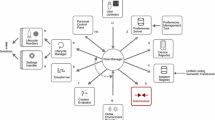Abstract
The first stage in the design of a user interface is the quest for its ‘typical user’, an abstract generalization of each user of the application. However, in web systems and other scenarios where the application can be used by dozens of different kinds of users, the identification of this ‘typical user’ is quite difficult, if not impossible. Our proposal is to avoid the construction of interactive dialogs during the design stage, building them dynamically once the specific cognitive, perceptual and motor requirements of the current user are known: that is, during the execution stage. This is the approach used by GADEA, an intelligent user interface management system (UIMS) able to separate the functionality of an application from its interface in real time. The system adapts the components of the interface depending on the information stored in a user model which is continuously updated by a small army of data-gathering agents.
Similar content being viewed by others
References
Reynolds C (1997) A critical examination of separable user interface management systems: constructs for individualization. In: ACM SIGCHI, vol 29, no 3, pp 41–45, July 1997
Schneiderman B (1988) Designing the user interface. Addison–Wesley, Reading. ISBN 0201694972
Calvary G, Coutaz J, Thevenin D, Limbourg Q, Souchon N, Bouillon L, Florins M, Vanderdonckt J (2002) Plasticity of user interfaces: a revised reference framework. In: Proceedings of the first international workshop on task models and diagrams for user interface design, pp 127–134
Kobsa, Koenemann J, Pohl W (2001) Personalized hypermedia presentation techniques for improving online customer relationships. In: The knowledge engineering review, pp 111–155
Weber G, Brusilovsky P (2001) ELM-ART: an adaptive versatile system for Web-based instruction. Int J Artif Intell Educ 12(4):351–384, Special issue on adaptive and intelligent web-based educational systems
De Bra P, Calvi L (1998) AHA: a generic adaptive hypermedia system. In: Proceedings of the 2nd workshop on adaptive hypertext and hypermedia (Hypertext’98), Pittsburgh, USA
Fink J, Kobsa A, Nill A (1998) Adaptable and adaptive information provision for all users, including disabled and elderly people. New Rev Hypermedia Multimedia 4:163–188
Foley J, Kim WC, Kovacevic S, Murray K (1991) UIDE, An intelligent user interface environment. In: Intelligent user interfaces. Frontier series. ACM, New York
Wahlster W (1991) User and dialog models for multimodal communication. In: Intelligent user interfaces. Frontier series. ACM, New York
Ferber J (1988) Conceptual reflection and actor languages. In: Maes P, Nardi D (eds) Metalevel architectures and reflection. North-Holland, Amsterdam
Card S, Stuart K, Moran T, Thomas P, Newell A (1983) The psychology of human–computer interaction. Lawrence Erlbaum Associates, Hillsdale
Newell A (1990) Unified theories of cognition. Harvard University Press, Cambridge
Lakoff G, Johnson M (1980) Metaphors we live by. University of Chicago Press, Chicago
Shulz E, Van Alphen M, Rasnake W (1997) Discovering user-generated metaphors through usability testing. In: Proceedings of the second international conference on cognitive technology, Aizu, Japan
Schwabe D, Rossi G (1995) Abstraction, composition and lay-out definition mechanism in OOHDM. In: Proceedings of the ACM workshop on effective abstractions in multimedia, San Francisco, CA
Gonzalez-Rodriguez M, Gonzalez-Gallego M, Rivera C, Pintado I, Vidau A (2006) Testing web navigation for all: an agent-based approach. In: Computers helping people with special needs. Lecture notes in computer science, vol 4061. Springer, New York, pp 223–229. ISBN: 3-540-36020-4; ISSN: 0302-9743
Gonzalez M (2002) Automatic data-gathering agents for remote navigability testing. In: IEEE Software, pp 78–85
Jul S, Furnas GW (1997) Navigation in electronic worlds: a CHI’97 workshop. In: ACM SIGCHI bulletin, vol 29, no 4, October 1997
Karn S, Keith S, Perry J, Thomas J, Krolczyk MJ (1997) Testing for power usability: a CHI 97 workshop. In: ACM SIGCHI bulletin, vol 29, no 4, October 1997
Salthouse T (1986) Perceptual, cognitive and motoric aspects of transcription typing. In: Psychological bulletin
Sternberg S (1969) Memory-scanning: mental processes revealed by reaction-time experiments. Am Sci 57:421–457
Brown JR (2001) Do you see what i mean? In: Workshop on universal accessibility of ubiquitous computing, Alcácer do Sal, Portugal
Dorigo M (1992) Optimization, learning and natural algorithms. PhD thesis, Politecnico di Milano, Italy
Dorigo M, Stützle T (2004) Ant colony optimization. MIT Press, Cambridge. ISBN 0-262-04219-3
Berkan, Riza C. (1997) Fuzzy systems design principles building fuzzy if–then rule bases. IEEE Press, New York
Author information
Authors and Affiliations
Corresponding author
Rights and permissions
About this article
Cite this article
Gonzalez-Rodriguez, M., Manrubia, J., Vidau, A. et al. Improving accessibility with user-tailored interfaces. Appl Intell 30, 65–71 (2009). https://doi.org/10.1007/s10489-007-0098-3
Received:
Accepted:
Published:
Issue Date:
DOI: https://doi.org/10.1007/s10489-007-0098-3




